
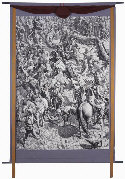
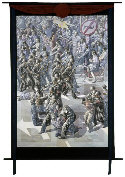
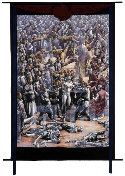
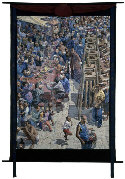
Decapitation Drawing & Quartering Firing Squad Flaying Starvation
Zhi Lin
Summer 2006
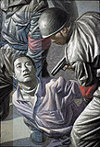
Interview Continued:
The most common case of government-sanctioned killing is the death penalty. In this country, politicians often play into our desire for security and our human propensity for cruelty by championing the use of capital punishment to resolve many social problems. It does not make the world safer, and a killing will never stop another; it will cause a new one in the future, a vicious cycle that doesn't end. We often hear people say that the death penalty was too easy on someone, and regard it as a civilized practice. However, when we look back at the history of penal system, we will have a different conclusion and put today's practice in a historical perspective. As a Chinese American, I felt strongly that I should examine this issue from the vantage of Chinese history. It not only allows the audience to make connections with contemporary events in China, but also to reexamine the culture and society in which we live.
Five Capital Executions has a clear reference to Wuxing, in Chinese, the five chief forms of ancient punishment: branding the face, cutting off the nose, cutting off the feet, castration, and decapitation. In order to challenge capital punishment in today's world, I changed the commonly known five forms of punishments to the following: Flaying, Decapitation, Starvation, Drawing and Quartering, and Firing Squad. Each of the five paintings are 12 ft. x 7 ft. and portrays crowds numbering 150 as witnesses to these horrific acts.
In the project "Five Capital Executions in China," I began to rethink my work and to search for answers from the narrative tradition in both the East and West. The transition from Modernism back to the traditional approach was difficult, but the urge to express my feelings about the times in which I live pushed me forward. And the pioneering work, such as that of Philip Guston and Paula Rego, provided me with insight to the transition as well as painting constructs and political ideas.
PC: What took you to the University of Delaware?
ZL: Location, location, and location. I remembered, in the summer of 1989, my teacher and friend, British painter Euan Uglow, asked me where I would like to go to school in North America? I gave him a list of four to five schools that accepted me. He told me that the location of UD was the best, I could easily access at least four major cities' museum collections and many commercial galleries. I was accepted by four to five other schools -- in Montreal, Boston, Chicago, and Houston, etc.
PC: You were working on the scrolls at The University of Delaware, and, if I remember correctly, drawings for them were a part of the thesis show?
ZL: Yes, the 1st piece of the project, Flaying, was a part of my thesis show. After the show, I worked on the painting further, and it was completed in the following year.
PC: You've painted children in these scrolls, for example, a child watches the beheading, placed where diagonals in the painting meet. Looking at the studies, the attention of the child is
ZL: The child has a reference to many European biblical paintings, massacred the innocence. The boy in this painting is standing, and in the Starvation, he is running deep into the painting from the foreground. Both of them are so innocent and artless, but they might inherit the tradition. In a foreseeable future, he could sell goods on street, sit at the table, be the soldier, or be one of the prisoners who are running out of the journey of life.3
Details and Studies relating to the scrolls: "Five Capital Executions in China"
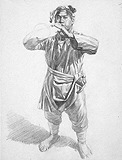
Trumpeter, study for Drawing and Quartering 2000 graphite on paper 11 x 8
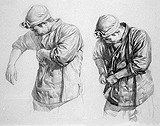
Two men buttoning up clothes, study for Drawing and Quartering 2000 graphite on paper 8 x 11

A detail image of Drawing and Quartering
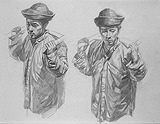
Two sedan carriers, study for Starvation 1996 graphite on paper 11 x 8
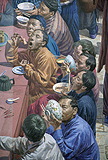
Detail of Starvation, Meat Noodle Eaters

Detail of
Starvation, Taunting man